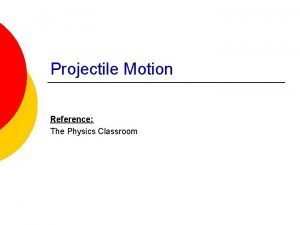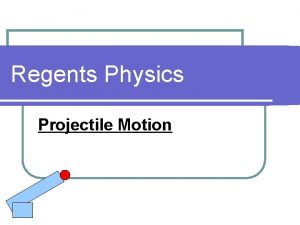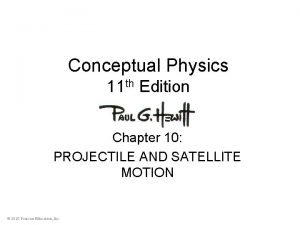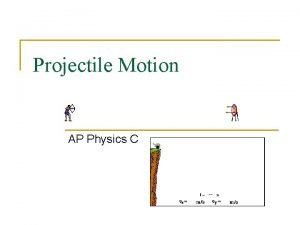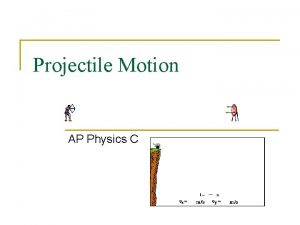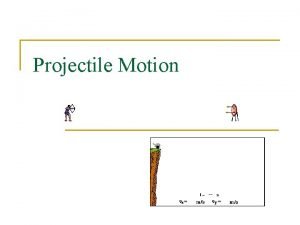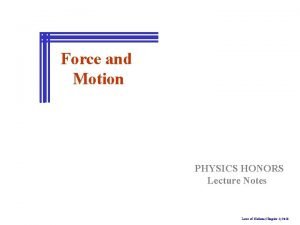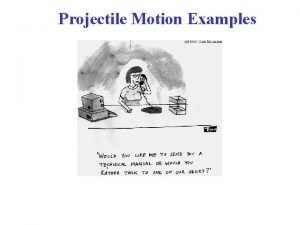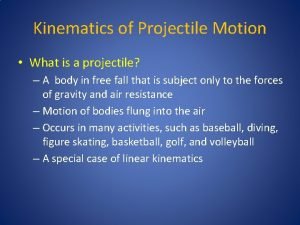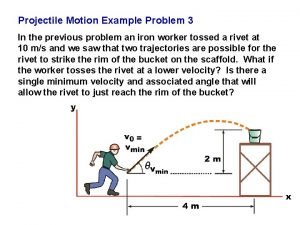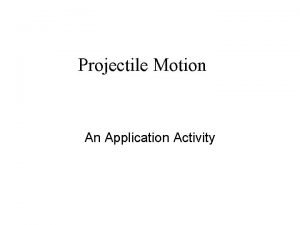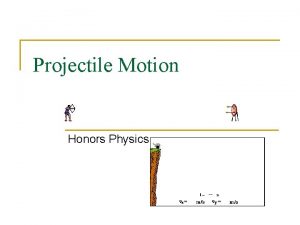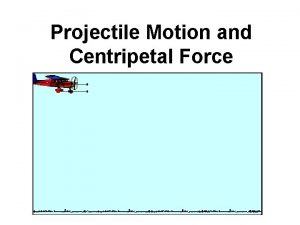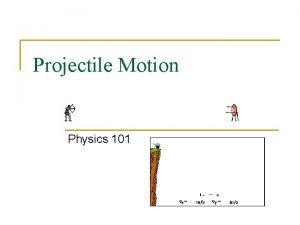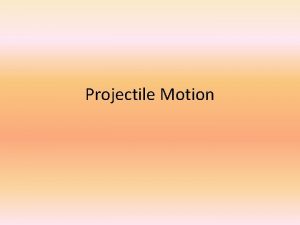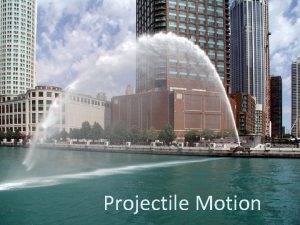Projectile Motion Honors Physics What is a projectile





















- Slides: 21

Projectile Motion Honors Physics

What is a projectile • A projectile is an object upon which the only force acting is gravity. • An object dropped from rest is a projectile (provided that the influence of air resistance is negligible). • An object that is thrown vertically upward is also a projectile (provided that the influence of air resistance is negligible). • An object which is thrown upward at an angle to the horizontal is also a projectile (provided that the influence of air resistance is negligible). • A projectile is any object that once projected or dropped continues in motion by its own inertia and is influenced only by the downward force of gravity.

Examples of Projectiles

Free-Body Diagram of a Projectile • A projectile has a single force that acts upon it - the force of gravity. • A free-body diagram of a projectile should show a single force acting downwards and labeled force of gravity (or simply Fgrav).

Characteristics of a Horizontal Projectile • There are two components of a projectile's motion - horizontal and vertical motion. These perpendicular components of motion are independent of each other, • The projectile travels with a constant horizontal velocity (inertia) and a downward vertical acceleration. (due to gravity)

In summary:

Non-Horizontal Projectiles • The projectile would travel along a straight-line, inertial path in the absence of gravity • Due to gravity the projectile would travel with a parabolic trajectory. The downward force of gravity would act upon the cannonball to cause the same vertical motion as before - a downward acceleration.

Check your understanding

A, B, None, B or C, B

Check your understanding


Check your understanding

• The answer is B. • The package will land directly below the plane. The horizontal motion of the falling package remains constant, and as such, the package will always be positioned directly below the plane. The force of gravity causes the package to fall but does not affect its horizontal motio

In Summary : • A projectile is any object upon which the only force is gravity, • Projectiles travel with a parabolic trajectory due to the influence of gravity, • There are no horizontal forces acting upon projectiles and thus no horizontal acceleration, • The horizontal velocity of a projectile is constant (a never changing in value), • There is a vertical acceleration caused by gravity; its value is 9. 8 m/s/s, down, • The vertical velocity of a projectile changes by 9. 8 m/s each second, • The horizontal motion of a projectile is independent of its vertical motion.

Horizontal Launch

Angular Launch

Another example

Calculating • Horizontal Displacement • d = vt • Vertical Displacement • d = vit + ½ at 2 • PRACTICE PROBLEMS

Vector Resolution of Components • Consider a projectile launched with an initial velocity of 50 m/s at an angle of 60 degrees above the horizontal. • Using trig functions, determine the horizontal and vertical components.

Solving

Determining the Time in Flight • The time for a projectile to rise to its peak is a matter of dividing the vertical component of the initial velocity (vi) by the acceleration of gravity (a). • Tup = Vi/a • Once the time to rise to the peak of the trajectory is known, the total time of flight can be determined. For a projectile that lands at the same height which it started, the total time of flight is twice the time to rise to the peak.
 Honors physics projectile motion test
Honors physics projectile motion test Projectile motion tennis ball
Projectile motion tennis ball Physics classroom
Physics classroom Projectile motion regents questions
Projectile motion regents questions Conceptual physics chapter 5 projectile motion answers
Conceptual physics chapter 5 projectile motion answers Physics projectile motion formula
Physics projectile motion formula What are two components of projectile motion
What are two components of projectile motion Physics javelin projectile motion
Physics javelin projectile motion Meaning of projectile motion
Meaning of projectile motion Projectile motion ap physics
Projectile motion ap physics Table 2.1.3 horizontal motion description
Table 2.1.3 horizontal motion description Projectile motion equation
Projectile motion equation Physics honors notes
Physics honors notes Honors physics semester 1 review
Honors physics semester 1 review Projectile motion examples
Projectile motion examples Relative projection height
Relative projection height Gerak parabola pada bidang miring
Gerak parabola pada bidang miring V
V Projectile motion objectives
Projectile motion objectives Projectile motion review
Projectile motion review What are two components of projectile motion
What are two components of projectile motion Motion
Motion


